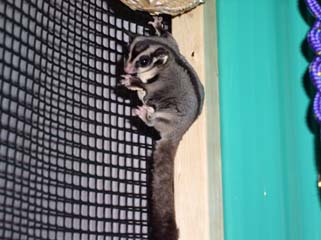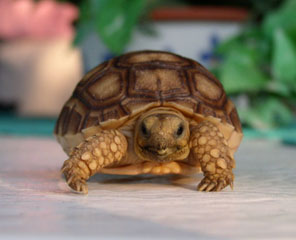This page includes information about the animals we use in our program.

|
Petaurus breviceps
The sugar glider is found in the forrests of Australia and parts of Indonesia and is one of the most common mammals in the area.
Sugar gliders are nocturnal, which means they have the opposite schedule from us! They sleep during the day, and are active during the night.
Gliders have furry membranes that extend from their ankles to their wrists that help them when they jump, or "glide".
Imagine this membrane as a parachute they put up when they want to glide from tree top to tree
top! If they are high enough, sugar gliders can glide as far as 150 feet! They use their long tails to
help them balance while gliding.
Sugar gliders are also marsupials, which means that, like kangaroos, the females carry their young,
in a pouch when they are first born, and when the joeys are old enough they crawl out of
the pouch.
|

|
Geochelone sulcata
Sulcatas are the third largest species of tortoise in the world; only the Galapagos and Aldabra tortoises get bigger! The average sulcata will reach between 18 and 30 inches by adulthood, and can weigh anywhere between 70-150 lbs.
Sulcata tortoises are native to more northern parts of Africa, ranging from the southern edge of the Sahara down through the arid countries, including Senegal, Mauritania, Mali, Niger, Chad, the Sudan, and Ethiopia, up through the dry, hot Massaua coast bordering the Red Sea.
Sulcatas will excavate pallets or burrows in the ground to get to areas with higher moisture levels; in the wild they may spend the hottest part of the day in these microhabitats. Burrows may average 30 inches in depth; some dig tunnel systems extending 10 feet or more underground.
|

|
Amazona aestiva
Blue fronted Amazon parrots grow to be around 12-16 inches from their head to tail feathers. They are known for their brilliant blue coloration found on the top of their head and around the facial area.
The blue fronts are found in South America within countries such as Brazil, Bolivia, Paraguay, and Northern Argentina. Their habitat consists of tropical woods and bush country where they make their homes in hollowed out trees during brooding, while living nomadically the remainder of the year.
Their diet consists of fruits, berries, greens, fresh corncobs, germinated sunflower seeds, and half-ripe wheat.
The blue front's talking abilities are among the top of the parrots and can live well over 70 years in captivity.
|

|
Gators are nice.
|
|
|



